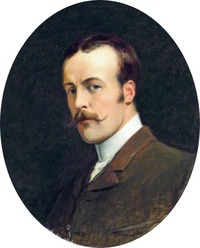This article includes a list of general references, but it lacks sufficient corresponding inline citations. (November 2016) |
Andrew Carrick Gow RA (15 or 18 June 1848 – 1 February 1920)[1] was a British painter who painted scenes from British and European history as well as portraits and genre.
Andrew Carrick Gow | |
|---|---|
 Self-portrait at the age of 35 (1883) | |
| Born | 15 or 18 June 1848 London, England, UK |
| Died | 1 February 1920 (aged 71) London, England, UK |
| Nationality | British |
| Elected | Member of the Royal Academy, 1890 |
Biography
editBorn in London in 1848, Gow studied at Heatherley's School of Art. He was a regular exhibitor at the Royal Academy, and elsewhere from 1867 onwards, and in 1881, he was elected an Associate of the Royal Academy, becoming a full Royal Academician in 1891. In 1900, he visited Egypt and he used his sketches to compose a scene representing the death of the Mahdi soon after the defeat of his troops by Colonel Wingate in 1898.
Gow's sister, Mary Gow, was also an artist, and the artist Lawrence Alma-Tadema was a close friend.
In later life, he became Keeper of the Royal Academy and died there on 1 February 1920 at the age of 72. He was buried on the western side of Highgate Cemetery.
Paintings
edit- The Relief of Leyden (1876 - Private Collection)
- A War Dispatch at the Hotel de Ville (1878 - Walker Art Gallery(?), Liverpool)
- "No Surrender" (French soldiers in loft after Ligny) (1879 - National Gallery of Victoria, Melbourne)
- Montrose at Kilsyth (1881 - Old Town Hall, Bedford)
- A Jacobite Proclamation (1882 - Art Gallery of New South Wales, Sydney)
- Trophies of Victory (Soldiers of the Dutch States General examining trophies captured at Battle of Nieuwpoort) (1883)
- Cromwell at Dunbar (1886 - Tate)
- The Garrison Marching Out with the Honours of War: Lille, A.D. 1708 (1887)
- A Lost Cause: Flight of James II after the Battle of the Boyne (1888 - Tate)
- Requisitioned (French cavalry stopped at by grain mill)
- A Search Party (French cuirassiers outside church, c. 1810) (1889 - Private Collection)
- The Visit of King Charles I to Kingston upon Hull, 1642 (1889)
- After Waterloo (Retreating French soldiers followed by Napoleon on horseback) (1890)
- The Duke in Spain (Wellington and staff during the Peninsular campaign)(1893)
- God Save James II (1894)
- On the Sands of Boulogne, 1805 (Napoleon and his staff) (1895 - Oldham Art Gallery)
- A Mountain Pass (French reconnoitering party in Spain) (1895 - Royal Academy of Art)
- The Emperor (Napoleon on his white charger) (1896)
- Waiting for Prince Charlie (Group of horsemen on sands) (1897)
- On the Way to Exile: The Arrival of the Emperor at Rochefort, 1815 (1897)
- The Signal (Horsemen on a beach) (1898)
- Queen Victoria at St. Paul's Cathedral on Diamond Jubilee Day (Guildhall Art Gallery)
- The death of the Khalifa
- Washington's Farewell to the Army (1902)
- Farewell to Nelson (1904 - National Maritime Museum)
- Royalist Prisoners (1913 - Parliamentarian soldier with Royalist woman and child)
- Nelson Leaving Portsmouth, 18th May 1803 (1903 - Royal Exchange, London)
References
edit- ^ Rohrschneider, Christine. "Gow, Andrew Carrick". AKL Online. Retrieved 17 January 2019.
- Harrington, Peter. British Artists and War: The Face of Battle in Paintings and Prints, 1700–1914. London: Greenhill, 1993.